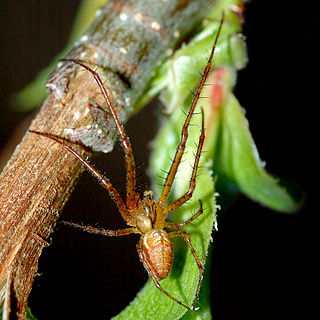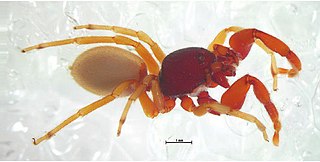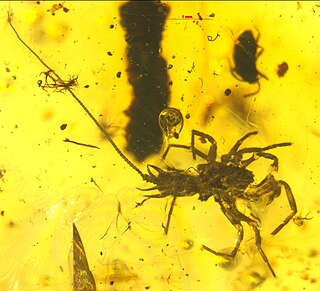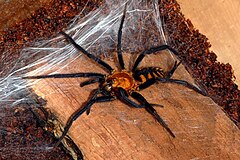
The Mygalomorphae, or mygalomorphs, are an infraorder of spiders, and comprise one of three major groups of living spiders with over 3,000 species, found on all continents except Antarctica. Many members are known as trapdoor spiders due to their creation of trapdoors over their burrows. Other prominent groups include Australian funnel web spiders and tarantulas, with the latter accounting for around one third of all mygalomorphs.

The Mesothelae are a suborder of spiders that includes a single extant family, Liphistiidae, and a number of extinct families. This suborder is thought to form the sister group to all other living spiders, and to retain ancestral characters, such as a segmented abdomen with spinnerets in the middle and two pairs of book lungs. Members of Liphistiidae are medium to large spiders with eight eyes grouped on a tubercle. They are found only in China, Japan, and southeast Asia. The oldest known Mesothelae spiders are known from the Carboniferous, over 300 million years ago.

The spider family Liphistiidae, recognized by Tamerlan Thorell in 1869, when broadly circumscribed to include two subfamilies, comprises 8 genera and about 100 species of medium-sized spiders from Southeast Asia, China, and Japan. They are among the most basal living spiders, belonging to the suborder Mesothelae. In Japan, the Kimura spider is well known. In 2022, it was proposed to re-accept the subfamily Heptathelinae as the family Heptathelidae. As of December 2023, this proposal was accepted by the World Spider Catalog. In this circumscription, the family Liphistiidae has only one genus, Liphistius.

Long-jawed orb weavers or long jawed spiders (Tetragnathidae) are a family of araneomorph spiders first described by Anton Menge in 1866. They have elongated bodies, legs, and chelicerae, and build small orb webs with an open hub with few, wide-set radii and spirals with no signal line or retreat. Some species are often found in long vegetation near water.

Hexathelidae is a family of mygalomorph spiders. It is one of a number of families and genera of spiders known as tunnelweb or funnel-web spiders. In 2018, the family was substantially reduced in size by genera being moved to three separate families: Atracidae, Macrothelidae and Porrhothelidae.

Microstigmatidae is a small family of spiders with about 38 described species in eleven genera. They are small ground-dwelling and free-living spiders that make little use of silk.

Palpimanidae, also known as palp-footed spiders, is a family of araneomorph spiders first described by Tamerlan Thorell in 1890. They are widely distributed throughout the tropical and subtropical regions of the world, the Mediterranean and one in Uzbekistan, but not Australia. They are not common and there is a high degree of endemism.

Archaeidae, also known as assassin spiders and pelican spiders, is a spider family with about ninety described species in five genera. It contains small spiders, ranging from 2 to 8 millimetres long, that prey exclusively on other spiders. They are unusual in that they have "necks", ranging from long and slender to short and thick. The name "pelican spider" refers to these elongated jaws and necks used to catch their prey. Living species of Archaeidae occur in South Africa, Madagascar and Australia, with the sister family Mecysmaucheniidae occurring in southern South America and New Zealand.
Masteria is a genus of curtain web spiders that was first described by L. Koch in 1873. They occur in the tropics of Central to South America, Asia and Micronesia, with one species found in Australia. M. petrunkevitchi males are 4 millimetres (0.16 in) long and females are 5 millimetres (0.20 in) long. M. lewisi, M. barona, and M. downeyi are slightly smaller and have only six eyes.
This list of fossil arthropods described in 2015 is a list of new taxa of trilobites, fossil insects, crustaceans, arachnids and other fossil arthropods of every kind that have been described during the year 2015. The list only includes taxa at the level of genus or species.

Chimerarachne is a genus of extinct arachnids, containing five species. Fossils of Chimerarachne were discovered in Burmese amber from Myanmar which dates to the mid-Cretaceous, about 100 million years ago. It is thought to be closely related to spiders, but outside any living spider clade. The earliest spider fossils are from the Carboniferous, requiring at least a 170 myr ghost lineage with no fossil record. The size of the animal is quite small, being only 2.5 millimetres (0.098 in) in body length, with the tail being about 3 millimetres (0.12 in) in length. These fossils resemble spiders in having two of their key defining features: spinnerets for spinning silk, and a modified male organ on the pedipalp for transferring sperm. At the same time they retain a whip-like tail, rather like that of a whip scorpion and uraraneids. Chimerarachne is not ancestral to spiders, being much younger than the oldest spiders which are known from the Carboniferous, but it appears to be a late survivor of an extinct group which was probably very close to the origins of spiders. It suggests that there used to be spider-like animals with tails which lived alongside true spiders for at least 200 million years.

Avicularioidea is a clade of mygalomorph spiders, one of the two main clades into which mygalomorphs are divided. It has been treated at the rank of superfamily.

Psilodercidae is a family of spiders first described as a subfamily of Ochyroceratidae by Machado in 1951 and raised to family rank by J. Wunderlich in 2008. These spiders can be distinguished by the "segestriid positioning" of their six eyes, the absence of leg bristles, strong apical bristles on the cymbium, and several pairs of spermathecae in females.
Priscaleclercera is a genus of araneomorph spiders in the family Psilodercidae, containing seven species. The genus was first described by Jorge Wunderlich in 2017, and its fossils have been found in Burmese amber, while live specimens have been found in Indonesia (Sulawesi).
Burmese amber is fossil resin dating to the early Late Cretaceous Cenomanian age recovered from deposits in the Hukawng Valley of northern Myanmar. It is known for being one of the most diverse Cretaceous age amber paleobiotas, containing rich arthropod fossils, along with uncommon vertebrate fossils and even rare marine inclusions. A mostly complete list of all taxa described up until 2018 can be found in Ross 2018; its supplement Ross 2019b covers most of 2019.
Fossilcalcaridae is an extinct Mygalomorphae spider family in the clade Avicularioidea containing the single species Fossilcalcar praeteritus. The family genus and species were described in 2015 from a male fossil entombed in Cretaceous age Burmese amber.
Euagridae is a family of mygalomorph spiders. The group was first described as a tribe in 1979 by Robert Raven, who in 1985 elevated it to a subfamily. In 2020, Opatova et al. elevated it further to a family.

Lagonomegopidae is an extinct family of spiders known from the Cretaceous period. Members of the family are distinguished by a large pair of eyes, positioned on the anterolateral flanks of the carapace, with the rest of the eyes being small. They have generally been considered members of Palpimanoidea, but this has recently been questioned. Members of the family are known from the late Early Cretaceous (Albian) to near the end of the Late Cretaceous (Campanian) of Eurasia, North America and the Middle East, which was then attached to Africa as part of Gondwana. They are generally assumed to have been free living hunters as opposed to web builders.
Jörg Wunderlich is a German arachnologist and palaeontologist. He is best known for his study of spiders in amber, describing over 1000 species, 300 genera, 50 tribes/subfamilies and 18 families in over 180 publications. Unlike most other arachnologists Jörg has never held any academic position and has worked as a private individual with no financial support for travel or equipment.













